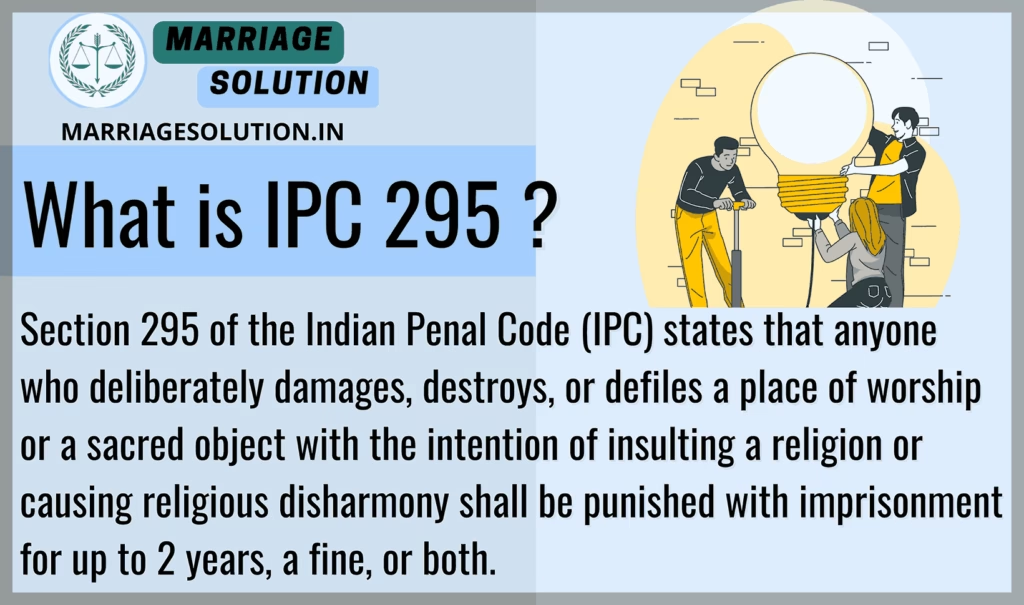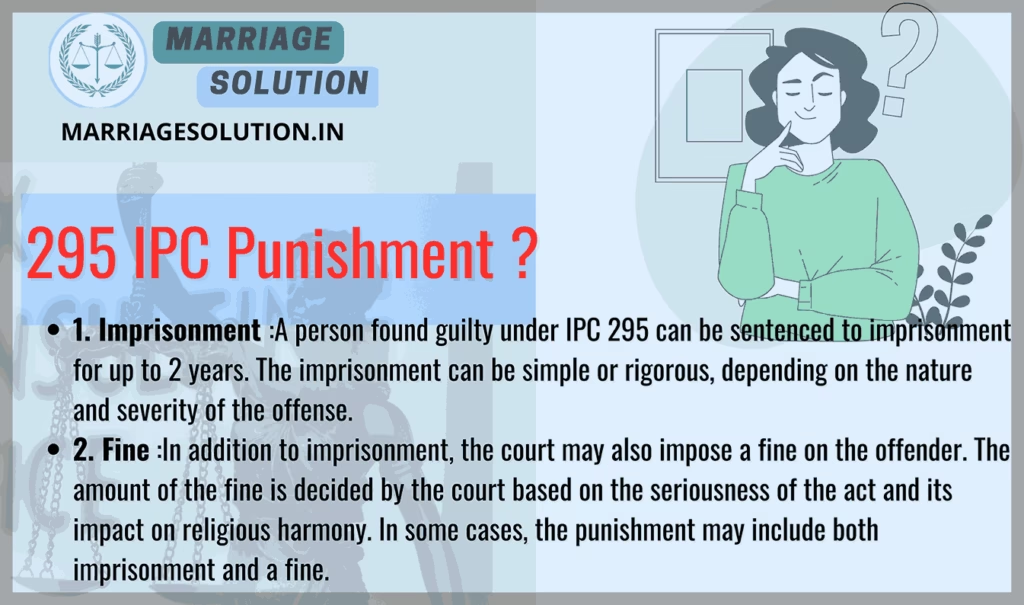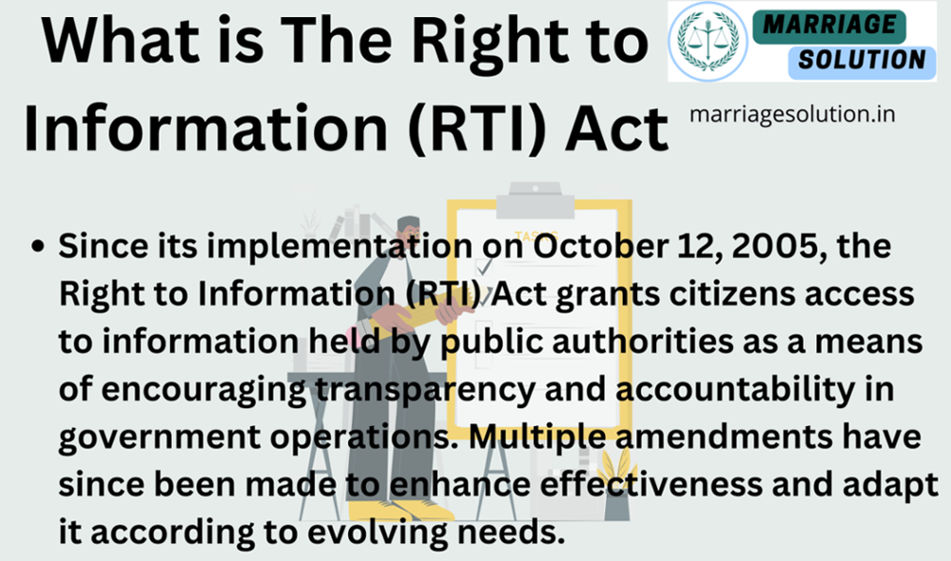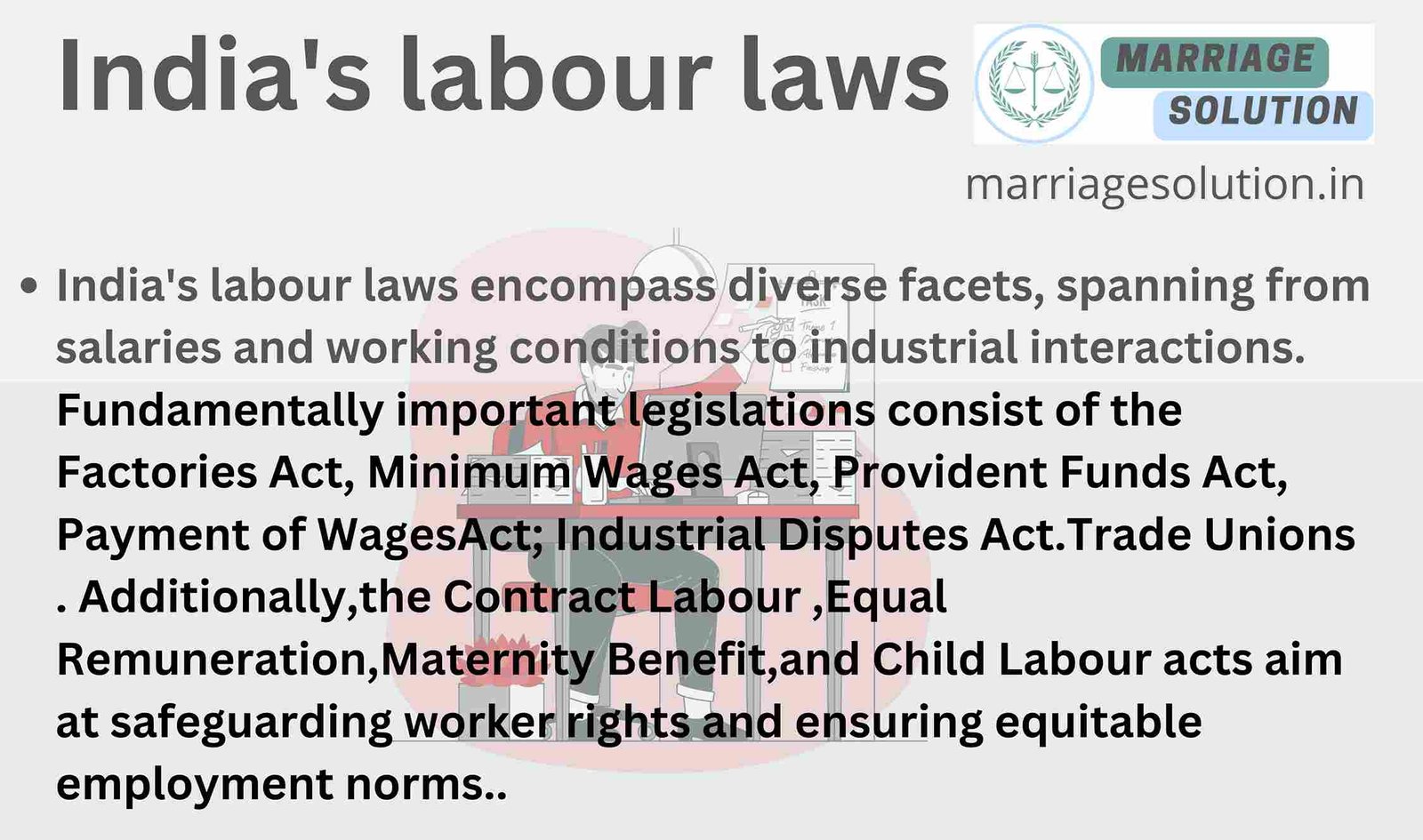Introduction of IPC 295
IPC 295 is a law that protects places of worship and religious objects from damage or defilement. The purpose of this section is to maintain religious harmony by punishing anyone who intentionally harms a place of worship or any sacred object. This law is essential in a country like India, where people from different religious backgrounds live together, ensuring respect for all faiths.
- Introduction of IPC 295
- What is IPC Section 295?
- Section 295 IPC in Simple Points
- Section 295A IPC in Simple Points
- Section 295 IPC Overview
- 10 Key Points on IPC 295
- 1. Protection of Religious Places and Objects
- 2. Intentional Act Required
- 3. Punishment Includes Imprisonment and Fine
- 4. Non-Bailable Offense
- 5. Cognizable Offense
- 6. Applicable to All Religions
- 7. Encourages Religious Harmony
- 8. Covers Physical Acts, Not Verbal Insults
- 9. Role of Police and Judiciary
- 10. Need for Strong Evidence
- Examples of IPC 295 Cases
- Section 295 IPC case laws
- 295 IPC Punishment
- 295 IPC Bailable or non bailable
- Section 295 IPC in short information
- IPC Section 295 FAQs
- If you need support with court proceedings or any other legal matters, don’t hesitate to reach out for assistance.
What is IPC Section 295?
Section 295 of the Indian Penal Code (IPC) states that anyone who deliberately damages, destroys, or defiles a place of worship or a sacred object with the intention of insulting a religion or causing religious disharmony shall be punished with imprisonment for up to 2 years, a fine, or both.

Section 295 IPC in Simple Points
1. Protection of Religious Places and Objects
IPC 295 protects places of worship, religious symbols, and sacred objects from damage, destruction, or defilement. This section ensures that religious sentiments of all communities are respected and prevents actions that may hurt people’s beliefs. Any act that deliberately damages a temple, mosque, church, or any sacred object falls under this law.
2. Intentional Damage is a Crime
For an act to be punishable under IPC 295, it must be done intentionally. This means that if a person knowingly destroys or defiles a place of worship or a religious object with the purpose of insulting a religion, it is considered a crime. Accidental damage does not fall under this section, but if done with malicious intent, legal action can be taken.
3. Punishment for Violating IPC 295
A person found guilty under IPC 295 can face imprisonment of up to 2 years, a fine, or both. The severity of the punishment depends on the extent of the damage and the intention behind the act. The law aims to prevent religious conflicts and communal tensions by punishing those who try to create disharmony.
4. Importance of IPC 295 in Maintaining Religious Harmony
India is a secular country with people from different religions living together. IPC 295 ensures that no one deliberately harms another community’s religious symbols or places of worship. This law helps maintain peace, protect religious sentiments, and prevent communal violence caused by offensive acts against any faith.
5. Difference Between IPC 295 and Other Religious Offense Laws
While IPC 295 deals with physical damage to religious places or objects, IPC 295A punishes those who intentionally insult religious beliefs through words or actions. Both laws aim to protect religious sentiments, but IPC 295 focuses on destruction or defilement, whereas IPC 295A deals with verbal or written insults.
Section 295A IPC in Simple Points
1. Protecting Religious Sentiments
IPC 295A was introduced to prevent deliberate insults to religious beliefs. Religion plays an important role in Indian society, and disrespecting religious faiths can lead to social unrest. This section ensures that no one can intentionally insult or attack a religion in a way that causes hatred or violence. However, accidental or unintentional statements are not covered under this law.
2. Forms of Religious Insult Under IPC 295A
This law applies to different forms of expression that can insult religion, including:
- Spoken or written words (such as hate speeches or articles).
- Signs or symbols (such as offensive posters or cartoons).
- Visible representations (such as movies, videos, or artwork).
If any of these are deliberately used to hurt religious sentiments, the person responsible can face legal consequences.
3. Punishment for Violating IPC 295A
Anyone found guilty under IPC 295A can be punished with imprisonment for a period of up to three years. Additionally, they may also have to pay a fine, depending on the severity of the offense. In some cases, the court may impose both imprisonment and a fine. This law ensures that people think carefully before making statements that could harm religious harmony.
4. Intent is Important in IPC 295A Cases
For an act to be punishable under IPC 295A, it must be done with deliberate and malicious intent. This means that the person must have knowingly and intentionally insulted a religion with the purpose of creating unrest or hurting religious feelings. If there is no proof of intention, the person cannot be punished under this section.
5. IPC 295A and Freedom of Speech
India’s Constitution provides freedom of speech to all citizens, but this freedom is not absolute. Hate speech or religious insults are not protected under free speech laws. IPC 295A ensures that freedom of expression is used responsibly and does not harm religious harmony. The law is meant to prevent communal tensions while protecting the right to express opinions in a respectful manner.
Section 295 IPC Overview
IPC 295 is a law that prevents intentional harm to religious places and objects. If someone damages, pollutes, or defiles a temple, mosque, church, or any sacred object with the purpose of hurting religious sentiments, they can be punished under this law. The main objective of IPC 295 is to preserve religious peace and prevent communal tensions.
10 Key Points on IPC 295
1. Protection of Religious Places and Objects
IPC 295 aims to protect places of worship and objects that hold religious significance. It prevents acts that intentionally damage or defile temples, mosques, churches, or sacred items. This ensures that religious sentiments are not hurt and communal harmony is maintained.
2. Intentional Act Required
For someone to be punished under IPC 295, their actions must be intentional. If a person damages a religious place accidentally, they cannot be held guilty. The law is applied only when there is a clear intention to insult or harm religious beliefs.
3. Punishment Includes Imprisonment and Fine
The punishment under IPC 295 includes imprisonment for up to 2 years, a fine, or both. The severity of the punishment depends on the extent of the damage and its impact on religious peace. Courts may increase the penalty if the act causes communal tension.
4. Non-Bailable Offense
IPC 295 is a non-bailable offense, meaning the accused cannot get bail as a right. The court has the discretion to grant or deny bail, depending on the seriousness of the case. This is because such acts can cause communal disharmony and public unrest.
5. Cognizable Offense
IPC 295 is a cognizable offense, which means that police can arrest the accused without prior approval from the court. Since the offense involves deliberate harm to religious sentiments, authorities take strict action to prevent any further communal disturbances.
6. Applicable to All Religions
The law applies equally to all religions in India. Whether it is a Hindu temple, Muslim mosque, Christian church, Sikh gurudwara, or any other religious place, IPC 295 protects all sacred places and objects from intentional damage or desecration.
7. Encourages Religious Harmony
IPC 295 helps maintain peace among different religious groups. By punishing those who damage religious places or objects, the law prevents communal violence and ensures respect for all faiths. This contributes to a harmonious society where all religions are treated with dignity.
8. Covers Physical Acts, Not Verbal Insults
IPC 295 only applies to physical damage to places of worship or sacred objects. It does not cover verbal insults or speech against a religion. Speech-related offenses fall under IPC 295A, which deals with deliberate insults to religious beliefs through words or gestures.
9. Role of Police and Judiciary
The police play a crucial role in enforcing IPC 295 by investigating cases, gathering evidence, and ensuring offenders are brought to justice. The courts determine the severity of the punishment based on factors like the extent of damage, intent, and impact on public peace.
10. Need for Strong Evidence
To convict a person under IPC 295, strong evidence is required. The prosecution must prove that the accused intentionally defiled or damaged a religious place or object. If there is no clear evidence of intent, the accused cannot be convicted under this section.
Examples of IPC 295 Cases
Example 1: Vandalism of a Religious Place
A group of individuals deliberately enter a mosque and damage religious texts and structures. This act is done with the intention of hurting religious sentiments. The accused are arrested under IPC 295 because they have intentionally defiled a place of worship. The court sentences them to two years of imprisonment and a fine to ensure that such communal acts are discouraged.
Example 2: Defiling a Sacred Idol in a Temple
A person throws ink and dirt on an idol inside a Hindu temple, knowing that such an act would offend devotees. The temple authorities file a complaint, and the police arrest the individual under IPC 295. Since the act was intentional and aimed at insulting religious sentiments, the person is punished with imprisonment and a fine.
Section 295 IPC case laws
1. Ramji Lal Modi v. State of Uttar Pradesh (1957)
Case Summary:
In this case, Ramji Lal Modi published articles in a magazine that contained offensive remarks about religious beliefs. The government banned the publication and charged him under IPC 295A (related to religious insults). The accused argued that this law violated freedom of speech.
Court’s Decision:
The Supreme Court upheld the constitutionality of laws that restrict speech if they are necessary to maintain public order. The court ruled that intentional harm to religious sentiments is punishable, and freedom of speech cannot be misused to create communal disharmony.
Result:
Ramji Lal Modi was found guilty, and the court reinforced that religious sentiments must be protected under the law.
2. Haji Mohammad v. State of West Bengal (1960)
Case Summary:
A group of people entered a mosque and desecrated sacred religious texts and prayer mats. This act angered the local Muslim community, leading to tensions in the area. The police arrested the individuals under IPC 295 for intentionally defiling a place of worship.
Court’s Decision:
The court held that any act that deliberately harms a place of worship is punishable under IPC 295. The court emphasized that religious places must be respected, and any attempt to damage them is a serious crime.
Result:
The accused were sentenced to imprisonment and a fine. The ruling helped reinforce protection of religious sites in India.
3. S. Veerabadran Chettiar v. E.V. Ramasamy (1958)
Case Summary:
In this case, E.V. Ramasamy, a social reformer, publicly broke an idol of Lord Ganesha to protest religious beliefs. Many Hindu devotees saw this act as offensive and filed a complaint under IPC 295.
Court’s Decision:
The court ruled that merely breaking an idol as a personal act of protest is not a punishable offense unless it is proven that the act was done with the intention of deliberately offending religious sentiments.
Result:
E.V. Ramasamy was acquitted because there was no proof that he intended to insult religious sentiments directly. The case clarified that only intentional defilement is punishable under IPC 295.
4. The State of Gujarat v. Mirzapur Moti Kureshi Kassab (2005)
Case Summary:
The Gujarat government banned cow slaughter, which affected the livelihood of some people from the Muslim community who traditionally engaged in cattle-related businesses. A case was filed, claiming that such bans interfere with religious freedom.
Court’s Decision:
The Supreme Court ruled that the ban was valid because cows are considered sacred in Hinduism, and protecting religious sentiments is part of maintaining public order. The court stated that actions that offend religious groups can be restricted to maintain communal harmony.
Result:
The ban on cow slaughter was upheld, and the case reinforced the importance of protecting religious sentiments while balancing fundamental rights.
5. Raj Kapoor v. State (1980)
Case Summary:
The famous actor Raj Kapoor produced a film that some religious groups claimed was offensive to their beliefs. A complaint was filed under IPC 295A, arguing that the movie contained scenes that insulted religious sentiments.
Court’s Decision:
The court ruled that films are a form of artistic expression, and only content that is deliberately offensive and intended to insult religious beliefs can be punished. The court held that censorship laws and film certification boards should handle such issues before legal action is taken.
Result:
The film was allowed to be released, and the court clarified that intentional religious defilement is necessary for punishment under IPC 295.
295 IPC Punishment
1. Imprisonment
A person found guilty under IPC 295 can be sentenced to imprisonment for up to 2 years. The imprisonment can be simple or rigorous, depending on the nature and severity of the offense.
2. Fine
In addition to imprisonment, the court may also impose a fine on the offender. The amount of the fine is decided by the court based on the seriousness of the act and its impact on religious harmony. In some cases, the punishment may include both imprisonment and a fine.

295 IPC Bailable or non bailable
- IPC 295 is a non-bailable offense, meaning the accused cannot get bail as a right.
- The decision to grant bail is at the discretion of the court, depending on the seriousness of the act and its impact on society.
- Since this offense can lead to religious tensions, courts often take strict action against those accused under this section.
Section 295 IPC in short information
| IPC Section | Offense | Punishment | Bailable/Non-Bailable | Cognizable/Non-Cognizable | Trial |
|---|---|---|---|---|---|
| IPC 295 | Deliberate damage or defilement of a place of worship or sacred object | Imprisonment up to 2 years, or fine, or both | Non-Bailable | Cognizable | Trial by Magistrate |
IPC Section 295 FAQs
What kind of acts are covered under IPC 295?
Any intentional damage, defilement, or destruction of a place of worship or a religious object is covered under IPC 295. This includes acts like vandalizing a temple, mosque, church, or any sacred object.
Is IPC 295 applicable to all religions?
Yes, IPC 295 applies to all religions in India. It ensures that no religious place or object is damaged and that people’s religious sentiments are respected.
Can someone be punished under IPC 295 for an accidental act?
No, IPC 295 applies only if the act is done deliberately. If the damage is accidental and without intention, the person cannot be punished under this section.
Can a person accused under IPC 295 get bail?
No, IPC 295 is a non-bailable offense. Bail can only be granted at the discretion of the court, depending on the circumstances of the case.
How is IPC 295 different from IPC 295A?
IPC 295 deals with physical damage to religious places or objects, whereas IPC 295A punishes those who intentionally insult religious beliefs through words, gestures, or actions.
If you need support with court proceedings or any other legal matters, don’t hesitate to reach out for assistance.
Court or any other marriage-related issues, our https://marriagesolution.in/lawyer-help-1/ website may prove helpful. By completing our enquiry form and submitting it online, we can provide customized guidance to navigate through the process.
Right to Information RTI act :Your Comprehensive Guide (Part 1)
The Right to Information (RTI) Act : Explore the essence of the Right to Information (RTI) Act through this symbolic image. The image features legal documents, emphasizing the importance of transparency and accountability in governance. The scales of justice represent…
What is Article 371 of Indian Constitution ?
Article 371 of the Indian Constitution grants special provisions to specific states and regions within India, addressing their unique historical, social, and cultural circumstances. These provisions aim to accommodate diverse needs and protect cultural identities within the constitutional framework.
Indian Labour law : Your Comprehensive Guide (Part 1)
The purpose of labour laws is to safeguard employees and guarantee equitable treatment at the workplace, encompassing aspects such as remuneration, security, and perks. These regulations establish a secure ambiance by imposing minimum wage requirements, ensuring factory safety measures are…
GST :Your Comprehensive Guide (Part 1 – Understanding the Basics)
The Goods and Services Tax (GST) is like a big change in how we pay taxes in India. It started on July 1, 2017, and it’s here to simplify things. Before GST, we had many different taxes, and it could…





